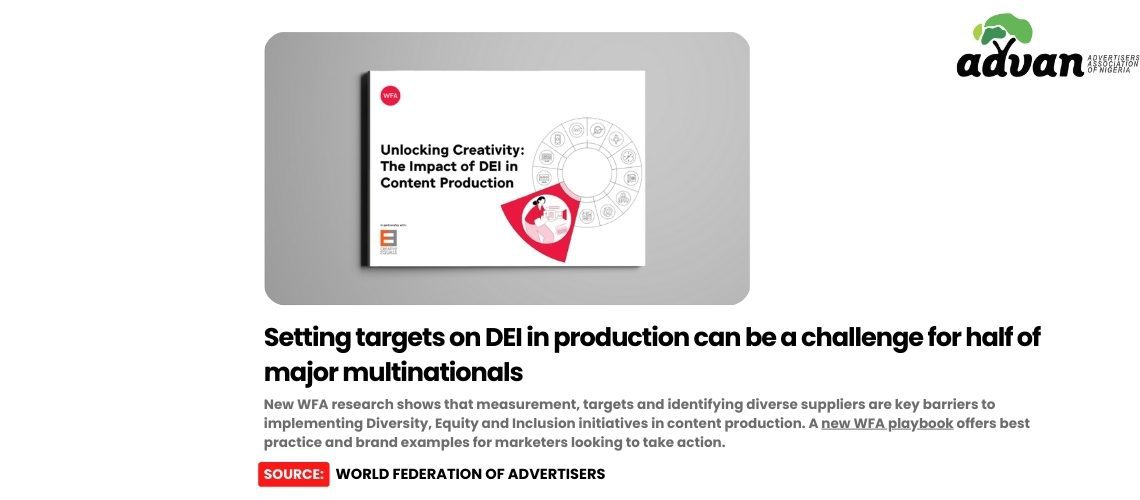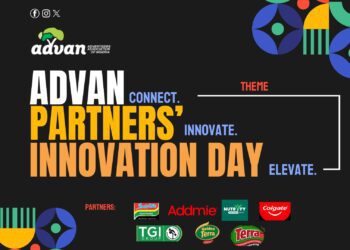New WFA research shows that measurement, targets and identifying diverse suppliers are key barriers to implementing Diversity, Equity and Inclusion initiatives in content production. A new WFA playbook offers best practice and brand examples for marketers looking to take action.
New research from the WFA reveals that nearly half of major multinationals (49%) are struggling to measure Diversity, Equity and Inclusion (DEI) efforts in the content production space and the same number find it hard to set consistent targets across markets and suppliers.
More than four in 10 are also struggling to identify diverse suppliers, with 22% saying that while driving DEI initiatives in the US is more straightforward, the rest of the world is a challenge.
That’s borne out by the fact that while 24% of multinationals describe their efforts in North America as very mature, 16% give the same credibility to their initiatives in Europe and 4% in LATAM. APAC and MEA scored zero on this measure.
Globally, 24% of brands always measure progress in relation to supplier diversity in production. A further 9% do so very frequently and 21% do so ‘occasionally’.
This relative lack of maturity is underscored by the fact that only one in three brands have been proactively incorporating DEI into their advertising production for the past 1-5 years, and almost a quarter of have only started to consider it in 2024.
The results are based on responses from 32 different companies with a total cumulative marketing and media spend of USD $81 billion last year. Seventy percent of respondents had global roles.
This is an area where DEI can play a significant role, given that 70% of respondents spend up to 20% of their total marketing budgets on content production. Critically, there has been little improvement in many of these numbers since the WFA last looked at the topic in WFA’s 2021 Global Content Production report.
The new research is highlighted in the WFA’s first-ever guide to embedding DEI in the content production process. Unlocking Creativity: The Impact of DEI in Content Production was developed by members of WFA’s Diversity & Inclusion taskforce in conjunction with DEI consultancy, Creative Equals, and outlines key processes that brands can rely on as they work towards improving their DEI performance and track outcomes. The playbook also offers a collection of learnings and best practice from some leading brands in this space, including Diageo, Haleon, Pepsi, P&G, Reckitt, Visa and Unilever.
Covering various areas of focus, from partner selection and pre-production to post-production as well as the potential impact of AI on DEI initiatives, the goal is to provide support to brands on their journeys to tackle the big challenges and make their productions more diverse and inclusive.
Success in this area is not just about ensuring that the people who appear on screen reflect the full range of human experiences, but also that the sets themselves are places where everyone can feel comfortable and expect their needs to be met.
The research found that while 5% of respondents had been working in this area for more than 15 years, most were at a much earlier stage of development. Thirty-four percent had been doing it for between one and five years and 24% had just started.
“As advertisers, the production ecosystem can feel complex, and challenging to ingrain conscious inclusion and the mechanisms to keep people and teams accountable. DEIB measures in production not only supercharge the effectiveness of creativity, but they also establish concrete metrics to evaluate and govern your key agency and production partners. This ensures that your brand leaves a positive imprint throughout the entire creative and production value chain,” said Efrain Ayala, Global Creative Effectiveness and Diversity & Inclusion Director, Reckitt, and WFA Global Diversity Ambassador.
Triple bid tactics is one of the key topics in the report. These involve ensuring that at when bidding for a job, least one representative of a minority group is presented to a brand for consideration in directing. Based on WFA’s research, tactics such as this one have been used by brands in an effort to boost diversity of directors in over 50% of cases by 34% of respondents, although anecdotal responses to WFA’s research indicate that this can be limited to just one facet of diversity, such as gender.
Other key findings from the research include:
- The number of brands tracking the representation of talent is due to expand massively this year, with another 36% of respondents due to start. Fourteen percent already track this internally and a further 14% do so via an external partner.
- Twelve percent of respondents say they always align on DEI goals and KPIs in production, with 24% saying they do so ‘very frequently’ and a further 41% doing so ‘occasionally’.
- One in five brands (21%) always make sure their casting specs clearly require a diverse range of races, ethnicities, genders, ages, ability and including veterans. Twenty-nine percent do the same ‘very frequently’ and 21% do so ‘occasionally’.
- Only six percent say they are always aware of how their production partners recruit, support and develop diverse talent. Eighteen percent do so ‘very frequently’ and 24% do so ‘occasionally’.
- Just six percent of respondents say they always offer DEI training programmes to production partners to help educate and foster inclusive behaviours and to stop unconscious bias. Eighteen percent do so ‘very frequently’ and 15% do so ‘occasionally’.
“Brand owners have a two-fold opportunity to promote a positive and progressive DEI agenda through the content they produce: first, by making sure that what happens in front of the camera is reflective of the diversity of people their brands serve, and secondly, by championing a diverse and inclusive culture on set, where everyone can feel like they belong. This new production guide is for those just starting their DEI journey or the seasoned brand marketers seeking to identify proven ways to leave a legacy of positive societal and business impact,” said Stephan Loerke, CEO, WFA.
“Whilst we still have much to learn, if more brands can make their production sets more inclusive, they will not only create more opportunities for persons with disabilities, but also benefit immensely from the creativity they will bring to our industry,” said Dana Cadden, Global Head of Advertising Production, Unilever.
“At Diageo, we believe that everyone from script to screen should be included. We’ve seen first hand the benefit of putting this at the core of our production processes – in the last year, over 50% of our global ads were shot by a female director or photographer. We know this is good for creativity, good for business, good for our industry and good for society,” said Grainne Wafer, Global Director, Beer, Guinness, Smirnoff & Baileys at Diageo.
“Client and agency agreeing on their joint DEI ambition at the beginning of a project is crucial. This keeps it top of mind during the iteration process and then seamlessly translate when the project reaches production. It’s ultimately about a “for humans by humans” mindset and important for everybody to remind themselves of this and keep each other honest at every step,” said Annie Lazarevski, Global Production Director, Havas.
“DEI is a proven model for growth and social impact when it’s woven throughout the marketing value chain. This is the new ROI – the Return on Inclusion. DEI in production delivers positive results for everyone,” said Ali Hanan, CEO and Founder, Creative Equals.
“We are observing that the process of including diverse suppliers in bidding is often treated as a tick box exercise, resulting in these suppliers not being selected. These potential suppliers invest significant time and financial resources in the bidding process, yet their chances of winning are relatively low. Until agency partners adopt a different mindset, this situation is unlikely to improve”, said Pat Murphy, Founder and CEO, MurphyCobb & Associates.
“Getting to great inclusive marketing outputs means thinking differently right across the marketing process, from the insights and briefs we write through to the media and technology we use to get it out into the world. At the very heart of that process is production, and this guide is a fantastic collation of challenges and best practice to help brands – big or small – step-change their approach and make the on-set environment truly inclusive,” said Jerry Daykin, global media expert and WFA Global Diversity Ambassador.
“In the fast-paced FMCG advertising sector, the rush to produce content quickly and on reduced budgets often compromises preparation, support, and safety on set. The lack of diverse crew, the inadequate translation of essential documents for foreign language speakers, and the scarcity of women directors highlight critical inclusivity gaps. Addressing these issues requires a consolidated, concerted effort with adequate resources and a unified direction to build an infrastructure that supports diversity, equity, and inclusion in every production aspect,” said Elizabeth-Peyton Jones, Founder and CEO, Talent Trust.
“This report is important because while there have been real efforts to improve diversity and inclusion across the production and advertising sector, measurement has been a week spot and needs to be improved. Production companies are committed to playing their part and want to work with advertisers and agencies who genuinely share that commitment- and who don’t just add contractual requirements to look like they are- but want to put the work in with us,” said Steve Davies, Chief Executive at Advertising Producers Association.









